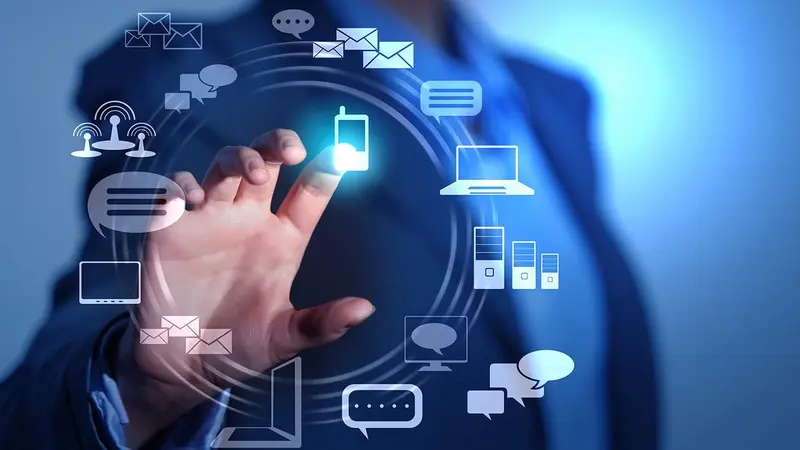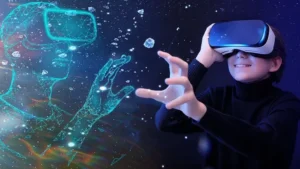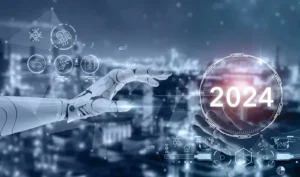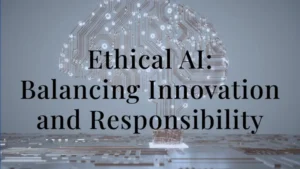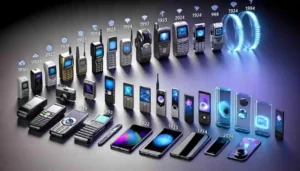Quick Link
For those who love technology, these are very exciting times as we are on the cusp of a new technological era. The speed at which technology and devices are developing is breaking records and completely changing the way we live, work, and interact with our surroundings. This year is set to set new records in the tech industry, from wearable technology to revolutionary advances in artificial intelligence and the revolutionary potential of 5G. We will go into more detail about a few of these fascinating advancements and how they might affect our day-to-day lives in the following section.
Development of Smarter Machines through AI

Since artificial intelligence embodies the cutting edge of technological advancement, its impact has been steadily increasing and permeating our daily existence. It encompasses a wide range of technologies, such as computer vision, natural language processing, and machine learning, where the fundamental goal is to emulate human intellect. The majority of apps are incorporating these technologies, which are causing drastic changes in various industries.
Data Analytics and Machine Learning

Machine learning, in which computers are taught on data to identify patterns and generate predictions based on those patterns, has shown to be one of AI’s most promising uses. Machine learning models are widely used in industries such as marketing, finance, and healthcare. For instance, AI systems can accurately identify anomalies in images such as tumours or fractures in health studies. These instruments can also be used to anticipate future health issues, allowing for early treatment.
In the finance industry, machine learning is also used to monitor suspected fraudulent activity by analysing transaction patterns. Adapting marketing methods to obtain insights into consumer behaviour is also beneficial. These tools not only greatly increase productivity but also provide insights that were previously impossible to obtain.
Natural Language Processing (NLP)
NLP is another essential component of AI, as it enables machines to produce and comprehend human language. A breakthrough has been made in this field: sophisticated chatbots and assistants that can join a user in conversation have been created. Current AI assistants include Google Assistant, which not only turns on and off smart home devices like Amazon Alexa but also reminds you of important occasions.
To improve even more conversational qualities, use Open AI’s GPT-4 NLP models, which are the most recent models. These models are skilled and imaginative content creators who also comprehend context and speak coherently. Future advancements in NLP technology will inevitably lead to more seamless human-machine interactions, which will improve user experience and efficiency.
Ethical Considerations and Future Directions
Despite its immense potential, artificial intelligence raises ethical concerns that need to be addressed. Concerns about algorithmic bias, employment displacement, and data privacy are at the centre of current AI discussions. Our ability to navigate this rapidly evolving field will depend on how fully AI systems can be made visible, equitable, and responsible.
In the future, AI is probably going to be incorporated into more and more commonplace items, such driverless cars and smart appliances. Businesses and consumers will need to become aware of and react to new opportunities and challenges that arise as artificial intelligence (AI) develops.
Exceeding Fitness Tracking in Wearable Technology

The market for wearable technology has come a long way from the first fitness trackers that were released. The features that modern wearables offer go well beyond simple health monitoring. The role of smart clothing and smart watches in improving our lifestyle and regulating our health is growing.
Over time, smartwatches have evolved into powerful tools for fitness and health. Contemporary models are equipped with extremely advanced sensors that monitor several health parameters, such as blood oxygen saturation, heart rate, and even ECG readings. With the help of the tools, users can monitor their progress, keep an eye out for health issues, and receive tailored recommendations based on data.
For those who love technology, these are very exciting times as we are on the cusp of a new technological era. The speed at which technology and devices are developing is breaking records and completely changing the way we live, work, and interact with our surroundings. This year is set to set new records in the tech industry, from wearable technology to revolutionary advances in artificial intelligence and the revolutionary potential of 5G. We will go into more detail about a few of these fascinating advancements and how they might affect our day-to-day lives in the following section.
Smart Clothing and Wearable Tech
Smart clothing, which incorporates sensors and electronics into regular clothing, is another example of how wearable technology is evolving. For example, smart shirts can monitor vital indications such as heart rate and body temperature, delivering up-to-the-moment feedback on physical performance. These clothes are useful for athletes who require precise recovery and rigorous performance tracking.
AR glasses represent yet another fascinating advancement in the wearables space. Actually, by superimposing digital data on the real environment, these glasses allow users to have a far more immersive experience, which may increase productivity and open up new and enjoyable ways to interact with goods and services. Such glasses can be equipped with interactive gaming experiences, real-time translation capabilities, or navigational directions while driving.
Future Trends in Wearables
Wearable technology is poised for many more creative applications as technological developments grow more established and commonplace. Further advancements in materials science and miniaturisation will make wearables increasingly more adaptable and comfortable. Additionally, the integration of wearable technology and AI will provide even more individualised health monitoring and insights, enhancing the usefulness of these technologies in our day-to-day activities.
5G Technology – A New Era of Connectivity
The introduction of this new technology would revolutionise wireless communication to a whole new level. More capacity and reduced latency would be offered by 5G compared to all of its predecessors. Many more new applications and the enhancement of existing ones will result from all these improvements in attributes being realised.
Augmented Mobile Experience
The most evident benefit of 5G is likely to be its ability to enhance mobile user experience. Phased at 100 times faster rates than 4G, 5G will speed up downloads, enable streaming of high-definition videos, and make online gaming more enjoyable. By allowing users to access and interact with documents and applications while on the go, mobile devices will help meet the growing need for data-intensive applications and increase productivity.
The fact that 5G technologies deliver better bandwidth and reduced latency in communication among articulated components, hence enabling smart cities and the Internet of Things, is equally significant. The development of intelligent settings is made possible by high bandwidth and low latency. Using real-time data to optimise traffic flow and minimise traffic bottlenecks are a few of instances of smart traffic management. Other examples include the more dependable and efficient operation of numerous home equipment.
Autonomous Vehicles and Remote Operations
Autonomous vehicles are another area where 5G will have a big influence. The real-time connection between cars and their accompanying infrastructure will require low 5G latency. This allows a self-driving car to make judgements on the fly, always relying on real-time Internet of Things data. Additionally, 5G will make remote operation possible in fields like robotics and telemedicine, where components may be operated more accurately and dependably from a distance.

Challenges and Considerations
With all of the advantages 5G is supposed to offer, there are drawbacks as well. The installation of 5G infrastructure necessitates extensive planning and funding. Concerns have also been raised regarding possible negative health effects of increased radiofrequency radiation exposure. As this technology develops further, it will be crucial to address these challenges to make sure the benefits outweigh the drawbacks.
Innovative Gadgets – Shaping the Future of Technology
The electronics industry is always evolving because to new devices and breakthroughs. In this sense, the most interesting developments may be found in smart home assistants, augmented reality gadgets, and sophisticated drones.
Smart Home Assistants
For the most part, smart house assistants are becoming helpful for the tasks that they can perform, which has led to their increasing appeal in contemporary homes. Voice commands can be used to adjust the settings of smart lights, thermostats, and other connected devices with both Google Nest and Amazon Echo. Natural language processing has advanced to the point where context-aware and topic-specific interactions are possible thanks to voice assistants like Google Assist.
The way we interact and view digital material is going to completely change as a result of augmented reality. AR glasses and headsets, for example, project digital data onto the real environment, allowing users to immerse themselves in both real and virtual aspects. Real-time information displays, improved navigation, and interactive gaming are some examples of applications. We’ll see this use become increasingly more innovative and widely used as the technology advances.
Advanced Drones
Drones of today are very different from those of that age or from their forebears, which were merely flying cameras. Modern devices have high-resolution cameras, obstacle avoidance features, and flight times. Due to all of these advantages, drones are now much more useful for a wide range of industries, including aerial photography, surveying, and delivery services. Drone technology is developing, creating new and exciting options for both professional and recreational use.
Embracing the Future of Technology
With fast advancements that keep adding to the collection of cutting-edge devices, the future appears more promising than it has ever been. The digital industry is developing at a relentless rate, and the revolutionary potential of 5G, the transformative power of AI, and the cutting-edge wearables and gadgets, to name a few, promise to impact our daily lives.
Awareness of these consumer and company advancements and their ramifications on embracing the technology for higher productivity with enhanced health management and linked experiences will be substantial. In addressing such obstacles, practical, ethical, and privacy concerns are equally important.
The future of technology is bright, with the promise of a booming potential. Engaging with these trends and leaning into the creation of innovations on the horizon presents one opportunity: to stride with confidence in the fluid landscape that technology presents.
For more content like this visit for online earning blogs visit autoearn or visit our Fcaebook page.
